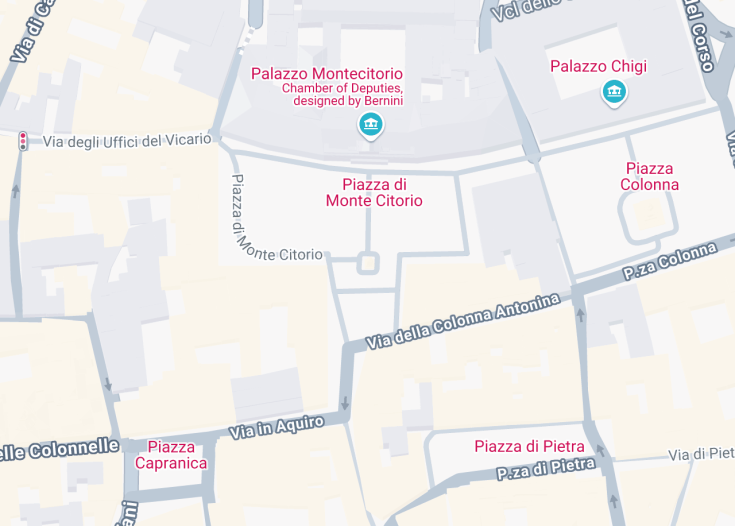The Obelisk of Montecitorio, also known as the Solare obelisk, is a remarkable ancient monument situated in the heart of Rome, Italy. Originally erected during the reign of Pharaoh Psamtik II, this stunning red granite structure stands as a testament to the grandeur of Roman architecture and the historical significance of the city, serving as a symbol of Augustus’s contributions to astronomy and architecture.
For visitors aiming to explore this extraordinary historical landmark, consider timing your visit early in the morning or late afternoon. These hours provide stunning natural light, enhancing the beauty of the obelisk and surrounding architecture, while also ensuring quieter conditions for photography.
While planning your trip to the Solare obelisk, take a moment to enjoy the surrounding Piazza Montecitorio. This vibrant square is not only home to the obelisk but also features the stunning Italian Chamber of Deputies, making it a perfect spot for cultural exploration.
“Solare” Obelisk at Piazza di Montecitorio: A Time-Defying Landmark
The Solare Obelisk, located in the historic Piazza di Montecitorio, stands as a breathtaking testament to Roman engineering and ancient Egyptian artistry. This towering structure, originally erected in Heliopolis, Egypt, was transported to Rome in 10 BCE by Emperor Augustus. It served a dual purpose as a gnomon for the famous Solarium Augusti, a solar clock that highlighted significant dates in Roman history, including Emperor Augustus’s birthday. Standing at an impressive 21.79 meters tall, the obelisk commands attention and captivates visitors who marvel at its intricate hieroglyphics and red granite construction. As a centerpiece in Rome’s political heart, the obelisk is also an integral part of the Italian Chamber of Deputies building, providing a striking backdrop for political events. Tourists flock to this historic site not only for its beauty but also to delve into its rich history, making the Solare Obelisk an essential stop for anyone exploring the wonders of Rome.
Explore the Historical Significance at the Solare Obelisk in Rome
When visiting the Solare Obelisk at Piazza di Montecitorio, you can explore various activities that enrich your experience.
Guided Tours
Witness expert-led tours that shed light on the obelisk’s storied past, the significance of its inscriptions, and its role in the grand narrative of Roman history.
Photography Opportunities
Capture memorable photos with the majestic obelisk as your backdrop, enhanced by the elegance of the nearby buildings.
Nearby Attractions
Visit the Chamber of Deputies and adjacent historical sites to gain a broader understanding of Italy’s legislative framework and cultural heritage. Your excursion to the Solare Obelisk offers an insightful glimpse into a remarkable intersection of history, art, and architecture.
An Interesting Fact about the “Solare” Obelisk at Piazza di Montecitorio
One intriguing aspect of the Solare Obelisk is its unique role as a solar clock. According to the ancient historian Pliny the Elder, this extraordinary mechanism indicated the passage of time through the shadow it cast. Notably, it was oriented to precisely align its shadow with the Ara Pacis on September 23, signifying the autumnal equinox and marking the birthday of Emperor Augustus. This meticulous alignment not only showcased architectural ingenuity but also emphasized Augustus’s claim to divine authority by intertwining nature, politics, and religion. Today, the obelisk remains a remarkable symbol of Rome’s historical continuity, representing the enduring legacy of its past.
Discover the Majestic “Solare” Obelisk at Piazza di Montecitorio in Rome, Italy
The Solare Obelisk, an ancient relic steeped in history, stands majestically in Piazza di Montecitorio, captivating visitors with its grandeur and significance. This stunning obelisk, originally from Egypt, dates back to the reign of Psamtik II and was later brought to Rome by Emperor Augustus in 10 BCE as part of his Solarium Augusti. The experience of visiting this iconic monument is perfect for history enthusiasts, architecture lovers, and anyone looking to immerse themselves in the enchanting atmosphere of Rome.
Visitors can expect to marvel at the tall, striking sandstone structure that rises 21.79 meters (71 feet) high, topped with a globe that reflects the sun’s rays brilliantly. The obelisk is adorned with intricate hieroglyphics that tell the story of its origin and honor the gods of ancient Egypt. Standing in front of the obelisk, one can easily imagine the historical significance it bore as a timekeeping marvel, originally serving as a gnomon for a massive sundial.
This monumental structure forms a pivotal part of a broader historical journey through Rome, connecting to significant nearby attractions such as the Ara Pacis and the Quirinal Palace. As you explore this area, you’ll find streets lined with cafes and shops, perfect for sampling local cuisine or enjoying a relaxing espresso amid the historical ambiance.
For those keen on gaining insights beyond the typical tour, consider visiting during the early morning or late evening when the obelisk is beautifully illuminated against the dusky sky, providing a unique photographic opportunity. Professional guides often share captivating stories about how the obelisk interacted with Roman culture and its legacy, enhancing your understanding of this remarkable site.
The Best Time to Visit the “Solare” Obelisk at Piazza di Montecitorio in Rome, Italy
The optimum time to visit the Solare Obelisk is during the early hours of the morning or late afternoons. This timing allows you to avoid peak tourist crowds while enjoying more tranquil surroundings. Additionally, the sundial aspect of the obelisk becomes even more striking under the warm glow of the setting sun.
Special Events
The annual celebration of the Autumn Equinox on September 23 is a particularly meaningful time to visit, as the shadow cast by the obelisk aligns perfectly with the steps of the nearby Ara Pacis, connecting the sun’s trajectory with the themes of peace Augustus promoted during his reign. Observing this phenomenon will add an extra layer of appreciation for the engineering and cultural significance behind the Obelisk’s placement.
Accessibility and Limitations
The Solare Obelisk is located in a public area, making it generally accessible to visitors. However, due to its urban setting, accessibility may vary based on the time of day and local events that may cause restrictions in the surrounding area.
Accessibility
- Paths around the obelisk are paved, facilitating wheelchair access.
- Public transport stops nearby provide convenience for all visitors.
- Avoid visiting during major events, as crowds may restrict access.
Limitations
- Occasional maintenance works may lead to temporary closures of nearby areas.
- Limited seating areas are available for those who may need to rest during their visit.
- Photographic restrictions may apply during specific events or ceremonies.
Notes to visitors
- Consider visiting with a guided tour for enhanced historical context.
- Be mindful of local weather conditions, as rain may deter outdoor activities.
- The obelisk is surrounded by busy streets; caution is advised while navigating the area.
General Information
Details for your visit to the “Solare” Obelisk at Piazza di Montecitorio
Location
The Solare Obelisk can be located near several significant landmarks, such as the Roman Pantheon and the Ministry of Defense. Its placement also connects to cultural venues and local eateries, perfect for a full day of exploring.
Address:
Piazza di Monte Citorio, 00186 Roma RM, ItalyVisiting Information
Visitors can freely access the obelisk at any time of day. For the best experience, it is advisable to visit during either early morning or later in the daytime when the sunlight enhances its magnificent features.
How to Reach the Destination
Reaching the Solare Obelisk is relatively simple, as it is well-connected by various modes of transportation.
Car
The obelisk can be easily reached by car. Nearby parking facilities are available for a nominal fee, making it convenient for those driving in.
| Route | Distance | Travel time |
|---|---|---|
| From Termini Station | 1.5 miles (2.4 km) | 10 minutes |
| From Vatican City | 2.2 miles (3.5 km) | 15 minutes |
| From Colosseum | 1.7 miles (2.8 km) | 11 minutes |
Public Transport
Rome’s public transport system can easily take you to the obelisk with several bus and metro lines servicing the area.
| Route | Distance | Travel time |
|---|---|---|
| From Termini Station (Metro Line A) | 1.5 miles (2.4 km) | 15 minutes |
| From St. Peter’s Basilica (Bus 87) | 2.2 miles (3.5 km) | 25 minutes |
| From the Colosseum (Metro Line B) | 1.7 miles (2.8 km) | 20 minutes |
Nearby Attractions
- Pantheon – 1.2 miles (1.9 km)
- Roman Forum – 1.5 miles (2.4 km)
- Palazzo Montecitorio – 0.1 miles (0.16 km)
- Quirinal Palace – 0.6 miles (0.96 km)
- Trevi Fountain – 0.9 miles (1.4 km)
- Ara Pacis – 0.5 miles (0.8 km)
- Fontana di Trevi – 0.8 miles (1.3 km)
- Santa Maria sopra Minerva – 0.7 miles (1 km)
- Vittoriano Monument – 0.9 miles (1.4 km)
- Colosseum – 1.7 miles (2.8 km)
- Piazza Navona – 0.8 miles (1.3 km)
- Capitoline Museums – 1.3 miles (2.1 km)
Common Questions
What is the history of the Obelisk of Montecitorio?
The Obelisk of Montecitorio, also known as the Solare, has a rich history dating back to ancient Egypt. Originally commissioned by Pharaoh Psamtik II around 595–589 BC, this ancient red granite obelisk was erected at Heliopolis, dedicated to the sun god Ra.
In 10 BCE, it was transported to Rome by Emperor Augustus to serve as a gnomon for his massive sundial, the Solarium Augusti, located in the Campus Martius. The obelisk not only functioned as a solar clock but also symbolically linked Augustus to divine authority, as it cast its shadow on the Ara Pacis during the autumnal equinox, coinciding with Augustus’s birthday.
The structure underwent significant changes over the centuries, including a collapse between the 9th and 11th centuries due to various calamities. It was later rediscovered and restored multiple times, especially during the papacies of Sixtus V and Pius VI. The obelisk now stands prominently in Piazza Montecitorio, a testament to its storied past and Roman heritage.
What are the inscriptions on the Obelisk of Montecitorio?
The Obelisk of Montecitorio features hieroglyphic inscriptions that celebrate Pharaoh Psamtik II and his status in ancient Egypt. The main inscription honors him as the Golden Horus, emphasizing his role as beloved of Atum, lord of Heliopolis. It conveys the pharaoh’s achievements as the King of Upper and Lower Egypt and emphasizes his divine lineage as the son of Re.
Additionally, the obelisk’s Pyramidion bears another inscription which invokes blessings for everlasting life and health from the deities, particularly Re-Horakhty, the great god, expressing a hope for the pharaoh’s continued reign.
When Augustus brought the obelisk to Rome, a new inscription recorded his accomplishments, declaring him “the son of the deified Julius Caesar,” and noted his role in bringing Egypt under Roman control. This multifaceted historical record encapsulates both the original Egyptian dedication and its transformation into a Roman symbol of power.
What architectural features can be observed at the Obelisk of Montecitorio?
The Obelisk of Montecitorio, one of the notable Egyptian obelisks in Rome, rises to an impressive height of approximately 21.79 meters (71 feet) and stands on a base that brings its total height, including the globe at the top, to about 33.97 meters (111 feet). Constructed from red granite, the obelisk showcases characteristic features of ancient Egyptian craftsmanship, including hieroglyphic carvings that serve both decorative and commemorative purposes.
Its base is intricately designed, displaying inscriptions that pay tribute to both the pharaoh whose original monument it was and the Roman emperor who relocated it. The obelisk’s orientation bears significance, as it was meticulously positioned to cast its shadow at specific times, turning it into a functional sundial.
The obelisk is mounted in Piazza Montecitorio, surrounded by important buildings, including the Italian Chamber of Deputies. The surrounding square features a modern layout that incorporates a new meridian tracing, a nod to the obelisk’s historical role in solar measurements.
What was the original purpose of the Obelisk of Montecitorio in ancient Rome?
Originally transported to Rome by Emperor Augustus in 10 BCE, the Obelisk of Montecitorio served as a crucial component of the Solarium Augusti, a grand sundial located in the Campus Martius. Its primary function was to act as a gnomon, casting a shadow across carefully marked lines on the ground, which indicated the time of day based on the sun’s position.
The obelisk was ingeniously aligned so that its shadow would touch specific points on the sundial during significant celestial events, such as the autumnal equinox. This alignment was not only practical but also symbolic, connecting Augustus to divine authority and reinforcing his role as a leader blessed by the gods. It signified the Roman view of time and the synchronization of earthly governance with celestial order.
Thus, the obelisk wasn’t simply a decorative monument; it was integrated into the fabric of Roman public life, serving both a scientific and a political purpose.
What is the significance of the location of the Obelisk of Montecitorio?
The location of the Obelisk of Montecitorio holds substantial historical and cultural significance. Positioned in Piazza Montecitorio, it is central to Italy’s political landscape as it stands directly in front of the Italian Chamber of Deputies. This adds a contemporary layer of importance, linking the ancient artifact to modern governance and civic life in Italy.
Originally, the obelisk was part of the Solarium Augusti in the Campus Martius, which symbolized Augustus’s power and his connection to the divine. The careful orientation of the obelisk, which allowed it to cast a shadow on the nearby Ara Pacis during special events, served to highlight Augustus’s divine right to rule and his aspirations for peace (Pax Romana).
Current efforts to incorporate a new meridian tracing in the square reference its ancient function as a solar timekeeper while grounding the obelisk firmly in the narrative of Rome’s ongoing history. This site serves as an intersection of ancient tradition and modern Italian identity, continually reaffirming the city’s role as a center of power.

Is the “Solare” Obelisk at Piazza di Montecitorio in Rome worth visiting?
The Obelisk of Montecitorio is undoubtedly a worthwhile spot for tourists exploring Rome. Standing at 21.79 meters tall, this ancient Egyptian obelisk serves as a striking testament to Rome’s rich historical tapestry. Erected as part of Emperor Augustus’s grand sundial in 10 BCE, its intriguing history adds depth to any visit. Moreover, the placement of the obelisk, designed to cast shadows on significant dates, reveals the engineering prowess and astronomical knowledge of the Romans. The restoration efforts by popes in subsequent centuries further enhance its allure, showcasing the commitment to preserving historical artifacts. While visiting the piazza, you can appreciate not just the obelisk but also the surrounding architecture, making this historic landmark a must-see for anyone interested in Rome’s ancient heritage.









